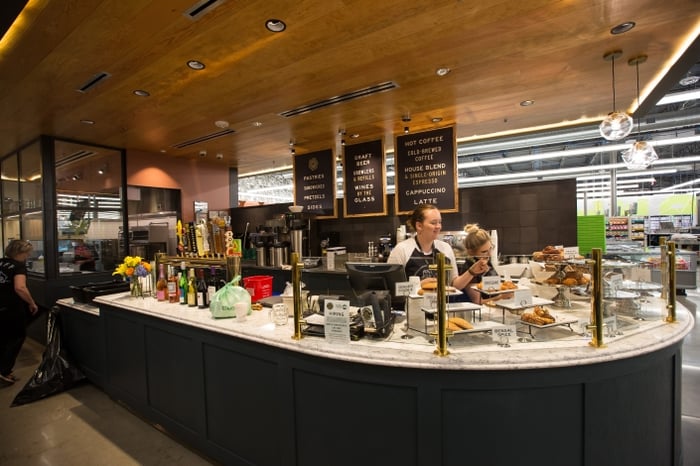Amazon.com (AMZN 1.30%) has been flirting with retail concepts that blur the line between e-commerce and bricks-and-mortar, and on Friday, the company made a huge bet that it can further reshape retail by acquiring Whole Foods Market (WFM) for $13.7 billion. While there are a lot of synergies associated with this deal (think supply chain), here are three less evident ways this acquisition could pay off for the Internet giant.
1. Dominating prepared foods and meal-kit delivery
As fellow Fool Daniel Kline pointed out in May, Whole Foods has opened 30 full-service restaurants and 250 quick-service locations in or adjacent to its stores to bolster its prepared-foods business.

IMAGE SOURCE: WHOLE FOODS MARKET.
This pilot program could allow Amazon to create a farm-to-dinner-table service that includes locally prepared foods and meal kits. In some markets, Amazon's already working with local restaurants to deliver prepared foods, and last fall it used its Amazon Fresh business to dip its toes into the meal-kit business.
The prepared-food market is highly competitive and undeniably big, so it's easy to see why Amazon would be interested in it. Meanwhile, the meal-kit market is growing rapidly, and someday, that could offer a meaningful source of sales too.
Recently, Blue Apron, the nation's leading meal-kit company, filed for an initial public offering, and that IPO news is generating a lot of hubbub around this service. Blue Apron's $795 million in sales last year would be a rounding error at Amazon's size, but given that Blue Apron's sales are growing at a 40% clip, its market is unquestionably a worthwhile opportunity for Amazon to explore.
If Amazon can rely on Whole Foods stores for purchasing and fulfillment, and use its own distribution expertise to remove delivery bottlenecks, then it's possible it could unseat Blue Apron and become the dominant player in this emerging market.
2. Checkout-less stores
In a bid to stave off competition from low-price food retailers like Aldi and Trader Joe's (both privately owned), Whole Foods has invested in its own program to sell brands exclusive to its stores. It sells about 5,300 of these products in its stores, plus hundreds of temporary exclusives that help build customer loyalty and generate repeat traffic. Last fiscal year, sales of those products, including the company's 365 Everyday Value private-label brand, totaled $2.3 billion.
The company's exclusivity program has been so successful that Whole Foods is in the process of rolling out a new retail-store concept around them, called 365 by Whole Foods. So far, it only operates a handful of these stores, but their small footprint and grab-and-go approach seems to dovetail perfectly with Amazon's recent test of a small, checkout-less food store in Seattle for its employees.
If Amazon can iron out the bugs associated with checkout-less technology, deploying it in small Whole Foods stores could be game-changing. That's especially true when you consider how much grocery stores spend on labor, and how much customers hate waiting in line.

IMAGE SOURCE: AMAZON.COM.
3. Distributing drugs someday?
Whole Foods finished last fiscal year with 456 retail stores, and those stores could someday be used by Amazon to fill shoppers' prescriptions.
Amazon is reportedly creating a pharmacy benefit manager that could eventually expand it into pharmacy retail. Whole Foods doesn't currently operate pharmacies in its stores, but it does sell vitamins and other health and beauty aids, and it's not a stretch to think that a pharmacy operation could be a great way to boost foot traffic.
Amazon certainly has the buying power and distribution experience to carve excess costs out of drug distribution. And it's toying with concepts in Japan that include partnering with existing pharmacies to fill prescriptions ordered online, after a patient completes a questionnaire and a pharmacist verifies the prescription.
If Amazon can combine online prescription ordering and fulfillment with in-store pickup, it could provide another great source of sales at Whole Foods stores, while also giving Amazon an entirely new source of revenue. Sure, this idea is only in the "who knows?" stage, but investors might not want to ignore how acquiring Whole Foods could help Amazon execute on its pharmacy aspirations.





